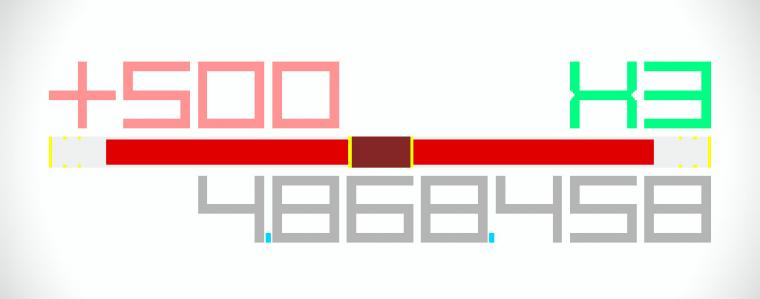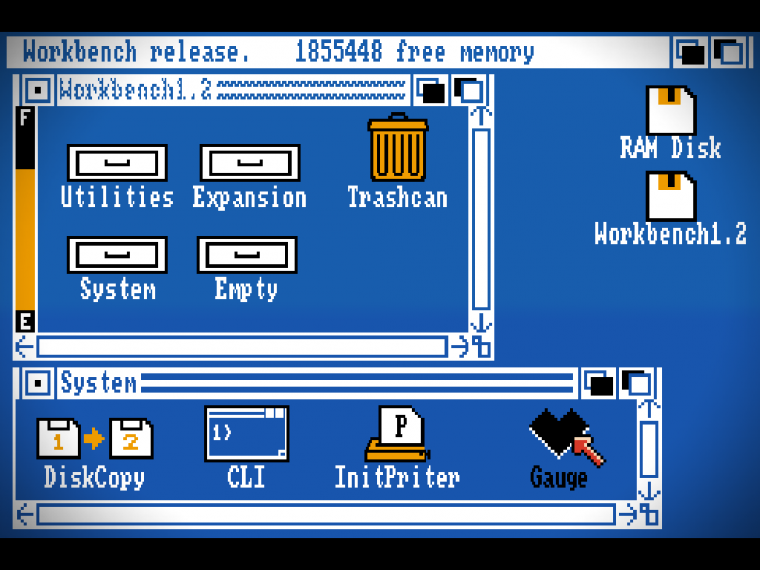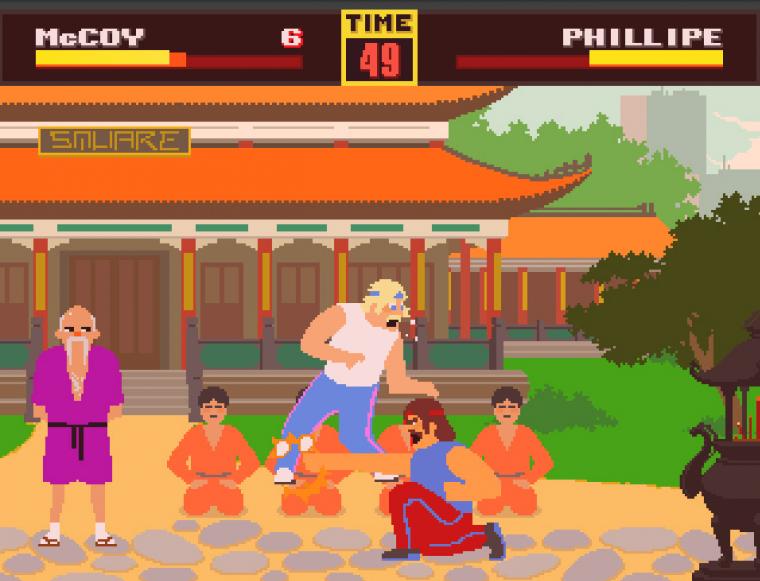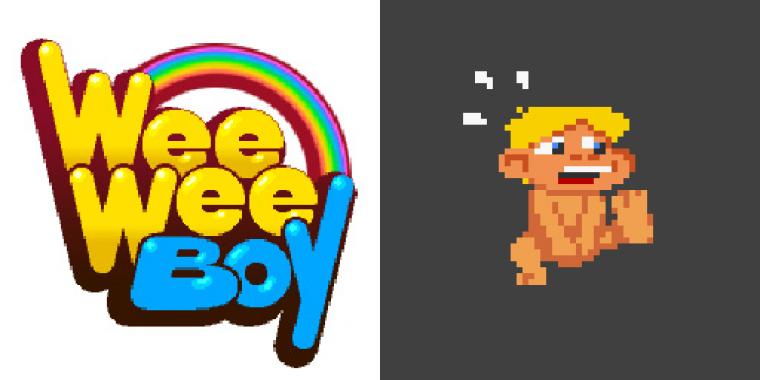He's retro to get you attracted

French indie developer Etienne Périn enjoys designing games as much as presenting them in the most striking ways possible. That is easier to do for him than for other devs, since as a fully fletched graphics designer, he is used to put games in beautiful audiovisual wrappings all the time anyway. Périn started his game career ten years ago and formed studio Yullaby with a bunch of friends in 2006, where he published his first offering Magnetis in 2009. Recently, Etienne caught some attention with the iOS port of his frantic beam balancing game Gauge (originally released as Freeware for Windows), which he published with fellow dev studio The Game Atelier. Gauge has absolutely nothing to do with the kind of one-button-game most of us are fairly used to by now. It is one of the best and craziest one-trick-ponys ever invented - you can find proof for that in the trailer video, too. But Gauge's creator has more titles up his sleeve - both ready to play and in development. VideoGameTourism caught up with the aspiring young designer and talked to him about inspiration, game nostalgia and the perfect balance between gameplay and graphics.
Where are you from, how old are you, what's your education and why did you get involved in creating games in the first place?
I'm from Lille, in the north of France, and I live in Paris for ten years now. I didn't do any game design school, I learned on the job. I started to make video games when I was 12 as a hobby, then I started to work in the video game industry at the age of 19 as a graphics designer. I'm now 29.
 Your oldest game in your online-portfolio is Magnetis from 2009, a Tetris-like puzzler, which - compared to your other games - now seems a little bit like a first test piece to get your skills in line. With "Square" and "Gauge" you seem to have found a distinct visual design as well as an affinity for simple game design solutions. Can you tell me a little bit about how these design ideas of yours developed throughout the last years?
Your oldest game in your online-portfolio is Magnetis from 2009, a Tetris-like puzzler, which - compared to your other games - now seems a little bit like a first test piece to get your skills in line. With "Square" and "Gauge" you seem to have found a distinct visual design as well as an affinity for simple game design solutions. Can you tell me a little bit about how these design ideas of yours developed throughout the last years?
Well, you're perfectly right about Magnetis, it was a kind of a test. I made it with a company I created with some friends a few years ago (Yullaby). The thing is, we couldn't find the time to make our own games with this company, we had to pay our employees and the rent. When the opportunity came to make an original game, we needed to think in simple and efficient terms, and a puzzle game like Magnetis seemed like a good concept to start with. In the case of Gauge and Square, it was a similar case because I wanted to finish theses games. When you start a game alone, you must be careful to not lose yourself in the amount of ideas and useless graphics (and as a graphic designer I often lose myself in graphics). In fact, when I started Gauge, I was working on a very ambitious Shoot 'em up. But the amount of work was too big for me, so I decided to go the opposite way, and to reduce my ideas to their most simple aspects. As a generale rule, I personally believe that a great game is always about just one or two good ideas, and that you need to push these ideas as far as you can via level design, bonuses and enemies. That's why I love arcade games. My next games shouldn't be as minimalistic as Square and Gauge though.
The love for arcade games also gets reflected in your archaic game design concepts. Gauge reminds me visually of Jeff Minter's games from the Eighties which celebrate a renaissance on iOS these days. You are also referencing old computers and their operating systems (Amiga, etc.). How important is this retro approach for you and how do you make sure that your game becomes more than just a well done hommage to old arcade classics?
When I started to work on the the PC version (which is now very different from the iOS version), I wanted to avoid this minimalistic/retro-ish aspect that all minimalistic games since Geometry Wars have. I didn't want a vector rendering at all, I was aiming at something that would be more like a numerical painting (I know, this can sound a bit arty/pretentious). A few months later, when I ported Gauge to iOS, I had to optimize my psychedelic effects, due to the iPhone memory limitations. I experimented for some time and eventually came up with these colorful blinking backgrounds you can see in the game. The first thing I thought was: "Cool, it looks like theses loading screen I used to see on my Amiga!". And I found it was even cooler to see this on an iPhone. You see, I don't like the iPhone very much. Don't get me wrong: The machine is great, but for me, it lacks a certain feel of imperfection and a human touch. Anyway, so now I was with thoses effects that looked like bugs, glitches and crashes, and I thought it would be interesting to show them on this perfect miniaturized computer. I pushed the idea as far as I could via multiple effects. I wasn't worried that the game itself could suffer because of theses retro elements - the core gameplay wasn't built on this idea. The gameplay was there before I introduced all theses arcade and home computer homages, and people already liked it as it was. It was more a way to enhance the experience and make it more accessible.
 Let's talk more about your artwork. You switch between styles a lot, including pixelated 16-bit-graphics, bright and clean characters and the already mentioned psychedelic colour palettes. Your new work-in-progress game Kung-Fu Warrior resembles old 8-bit fighting games - both in terms of graphics and gameplay. How do you choose to work on a certain artstyle and how do you want it to relate to the gameplay?
Let's talk more about your artwork. You switch between styles a lot, including pixelated 16-bit-graphics, bright and clean characters and the already mentioned psychedelic colour palettes. Your new work-in-progress game Kung-Fu Warrior resembles old 8-bit fighting games - both in terms of graphics and gameplay. How do you choose to work on a certain artstyle and how do you want it to relate to the gameplay?
Well, it depends on three parameters. First, it's about team size, time and money. Since I'm making games alone theses days, I got back to pixelated graphics more for practical reasons. With pixels you get a nice atmosphere and good animations more quickly. When you're working alone, you need to have quick results, it's better for the motivation. As for the connection with the gameplay, let's say it happens naturally. There is a way to animate a character or drawing stuff more efficiently, in a way that will fit with the gameplay. It's hard to explain, it's the kind of thing you have to experience yourself and that you only understand by developing or testing a game yourself. In a game like Kung-Fu Warrior, I also use pixels to honor classic games like Yie-Ar Kung-Fu or IK+, but - as I said - the main reason for this is because it allows me to add content to the game more quickly (and I want this game to be rich in content). I don't work on gameplay first and add graphics and sounds later on. No, I work on all of theses elements at the same time. Sometimes, a sound can cause me to change an animation, for example. Still, I believe that graphics, music and sounds are just there to attract players to a gameplay. Personally, I often have gameplay ideas that come from certain feelings or characters I have in mind. That was the case on Kung-Fu Warrior and another game I'm working on called Weewee Boy. Sometimes, I have pure gameplay ideas, and the result are games like Gauge, Square or Magnetis. I don't necessarily try to add a audiovisual universe to my gameplay ideas at the same time. It's a great challenge to try to stand out with only gameplay and maybe some sounds - especially for a graphics designer like me.
 Can you tell me more about your interface concept with Kung-Fu Warrior? What's behind the idea of just having one action button? And what is Weewee Boy?
Can you tell me more about your interface concept with Kung-Fu Warrior? What's behind the idea of just having one action button? And what is Weewee Boy?
Well, I like it when games don't have useless buttons or a lot of menus and tutorials that stand in the way. When I start a new game - whatever the genre - I try to do something a little new and orginal, be it with the controls or the rules. Regarding Kung-Fu Warrior: The funny thing with 2D fighting games is, that its genre hasn't evolved a lot over time. The way of playing a 2D fighting game is basically still the same as it was with Street Fighter II. When I was a kid I used to play IK+ and Yie-Ar Kung-Fu a lot, and the main idea behind Kung-Fu Warrior was to rethink their controls, but in a more dynamic way, adding to it what we learned from new game design concepts that came up over the last 20 years. And the other thing is, that it would be useless to try to make a game with controls like Street Fighter IV as a single person. Aside from that, Street Fighter IV does its job perfectly anyway, there is no need to try to do the same thing twice. The purpose of Kung-Fu Warrior is to mix two kind of games I love: Amiga and Neo Geo games. This is not obvious yet, because the game is far from being finished. It takes me a lot of time to develop it, and these days, the development of this game is on pause, unfortunatelly. That's why I started Weewee Boy, because it is way more easier to develop than Kung-Fu Warrior. Weewee Boy is a platformer in which you play a kid who always wants to pee. You need to finish the levels before he pees all over the place. At first, I made it as a Flash version, but I think I'll do it for the iPhone, too, as it's a one button game.

